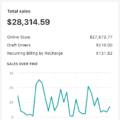The word intuitive, as defined at Dictionary.com, is an adjective with the following meaning: “Easy to understand or operate without explicit instruction; as in an intuitive design; an intuitive interface.” This is important to keep in mind when considering ways to make shopping your ecommerce store more intuitive. The more you can do to make using your site feel like second nature to shoppers, the happier they will be. Yes, a cool, hip and edgy design will set your store apart from all others. However, incorporating offbeat controls and functions just for the sake of design is a key ingredient in the recipe for high bounce rates.
Ease of Navigation Is Critical
By now, most people who visit your store will have previously shopped online. This makes your task somewhat easier, as there is now an established “language” with which users are familiar when it comes to finding their way around websites. As an example, most ecommerce sites place the shopping cart icon at the top right side of the page. This is where users have come to expect it to be and it’s the first place they’ll look for it. Reward them by placing yours there. Similarly, all of your navigation processes should be consistent throughout the site. Give people what they’re used to seeing in other places and they’ll have an easier time.
Converting website visitors to clients willing to purchase products is not easy. As a website owner, you have to use every tool at your disposal to keep visitors browsing on your website and eventually entice them to make purchases. Clever ecommerce merchandising techniques like strategic placement of photographs grouped by category can help. The use of such merchandising techniques originated in brick-and-mortar stores where products are arranged strategically on shelves. When applying online visual merchandising techniques to a website, you must adapt your strategy within the confines of a virtual store. Use of videos, categorized product lists and written or visual testimonials are all necessary to keep the interest of potential customers.
Maintain Established Conventions
As we touched upon above, users expect websites to behave in certain ways. The more the functioning of your site adheres to those conventions, the easier it will be for users to figure out. People have come to expect a click on your logo to take them to your homepage—regardless of where they are in your site. Links in copy should be made to stand out from normal text. Always place contact information in the footer. When included in navigational menus, make the contact button the last one on the right in a horizontal and have it be the one at the bottom in a vertical. If scrolling is required, show them a scrollbar to convey that information. Make sure your website theme employs simple language for buttons to ensure comprehension by the largest number of people possible.
Mobile Is Different—Somewhat
Smaller screens mean less real estate, which means a few different processes. You have to make some allowances for the reduced size. Product images should allow users to zoom with “spread and pinch” movements. If the user needs to input numbers, have a numerical keyboard appear.
Auto-correct might be good for messaging and email apps, but it’s a pain if your customer is trying to enter their name and address in a “Ship To” field. Disable it in those circumstances. Anything you can do to reduce the number of moves required to accomplish a task is worth doing, as long as it remains second nature to the user. Also, when you’re devising a user interface for mobile devices, take care to ensure it works on every currently available platform.
Mobile users tend to be less patient than their desktop counterparts, so fast loading is crucial. Similarly, allow users to scan credit cards—rather than fiddle with a tiny keyboard—to enter payment data. Additionally, give them the option to save payment and shipping information to make future purchases more quickly achievable.
Final Thoughts on Making eCommerce Shopping More Intuitive
Every effort you expend to incorporate these ways of making your ecommerce store more intuitive will pay off in ease of use, low bounce rates, longer user engagement and, ultimately, more sales.









